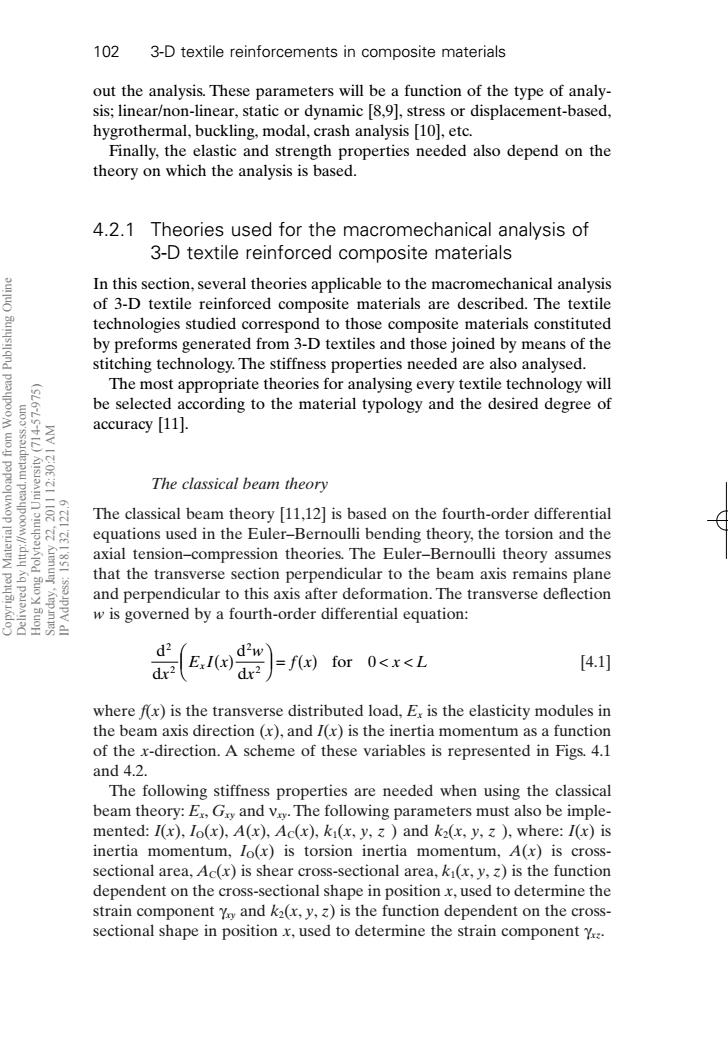正在加载图片...

102 3-D textile reinforcements in composite materials out the analysis.These parameters will be a function of the type of analy- sis;linear/non-linear,static or dynamic [8,9],stress or displacement-based, hygrothermal,buckling,modal,crash analysis [10],etc. Finally,the elastic and strength properties needed also depend on the theory on which the analysis is based. 4.2.1 Theories used for the macromechanical analysis of 3-D textile reinforced composite materials In this section,several theories applicable to the macromechanical analysis of 3-D textile reinforced composite materials are described.The textile technologies studied correspond to those composite materials constituted by preforms generated from 3-D textiles and those joined by means of the stitching technology.The stiffness properties needed are also analysed. The most appropriate theories for analysing every textile technology will poo be selected according to the material typology and the desired degree of accuracy [11]. The classical beam theory The classical beam theory [11,12 is based on the fourth-order differential pua equations used in the Euler-Bernoulli bending theory,the torsion and the axial tension-compression theories.The Euler-Bernoulli theory assumes that the transverse section perpendicular to the beam axis remains plane 豆 and perpendicular to this axis after deformation.The transverse deflection w is governed by a fourth-order differential equation: [4.1 where fx)is the transverse distributed load,Ex is the elasticity modules in the beam axis direction (x),and I(x)is the inertia momentum as a function of the x-direction.A scheme of these variables is represented in Figs.4.1 and 4.2. The following stiffness properties are needed when using the classical beam theory:E Gy and vy.The following parameters must also be imple- mented:I(x),lo(x),A(x),Ac(x),ki(x,y,and k2(x,y,z )where:I(x)is inertia momentum,lo(x)is torsion inertia momentum,A(x)is cross- sectional area,Ac(x)is shear cross-sectional area,ki(x,y,z)is the function dependent on the cross-sectional shape in position x,used to determine the strain component Yo and k2(,y,z)is the function dependent on the cross- sectional shape in position x,used to determine the strain component Y.102 3-D textile reinforcements in composite materials out the analysis. These parameters will be a function of the type of analysis; linear/non-linear, static or dynamic [8,9], stress or displacement-based, hygrothermal, buckling, modal, crash analysis [10], etc. Finally, the elastic and strength properties needed also depend on the theory on which the analysis is based. 4.2.1 Theories used for the macromechanical analysis of 3-D textile reinforced composite materials In this section, several theories applicable to the macromechanical analysis of 3-D textile reinforced composite materials are described. The textile technologies studied correspond to those composite materials constituted by preforms generated from 3-D textiles and those joined by means of the stitching technology. The stiffness properties needed are also analysed. The most appropriate theories for analysing every textile technology will be selected according to the material typology and the desired degree of accuracy [11]. The classical beam theory The classical beam theory [11,12] is based on the fourth-order differential equations used in the Euler–Bernoulli bending theory, the torsion and the axial tension–compression theories. The Euler–Bernoulli theory assumes that the transverse section perpendicular to the beam axis remains plane and perpendicular to this axis after deformation. The transverse deflection w is governed by a fourth-order differential equation: [4.1] where f(x) is the transverse distributed load, Ex is the elasticity modules in the beam axis direction (x), and I(x) is the inertia momentum as a function of the x-direction. A scheme of these variables is represented in Figs. 4.1 and 4.2. The following stiffness properties are needed when using the classical beam theory: Ex, Gxy and nxy. The following parameters must also be implemented: I(x), IO(x), A(x), AC(x), k1(x, y, z ) and k2(x, y, z ), where: I(x) is inertia momentum, IO(x) is torsion inertia momentum, A(x) is crosssectional area, AC(x) is shear cross-sectional area, k1(x, y, z) is the function dependent on the cross-sectional shape in position x, used to determine the strain component gxy and k2(x, y, z) is the function dependent on the crosssectional shape in position x, used to determine the strain component gxz. d d d d for 2 2 2 2 0 x EIx w x x ( ) fx x L Ê Ë Á ˆ ¯ ˜ = ( ) < < RIC4 7/10/99 7:43 PM Page 102 Copyrighted Material downloaded from Woodhead Publishing Online Delivered by http://woodhead.metapress.com Hong Kong Polytechnic University (714-57-975) Saturday, January 22, 2011 12:30:21 AM IP Address: 158.132.122.9